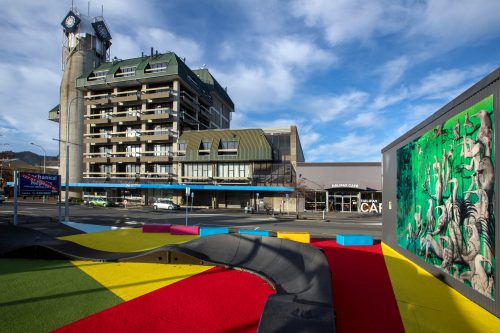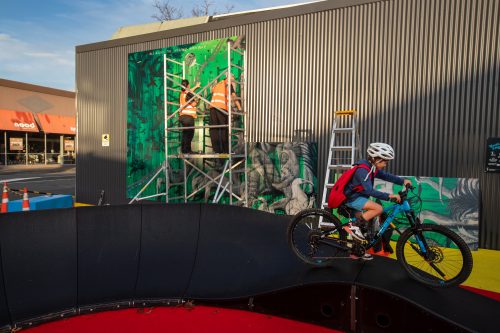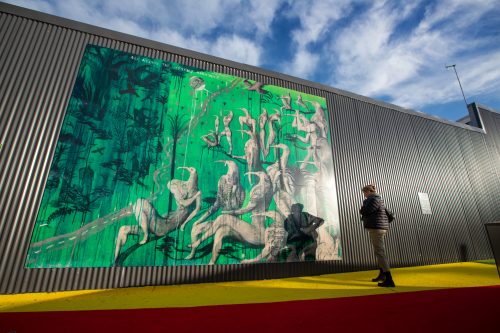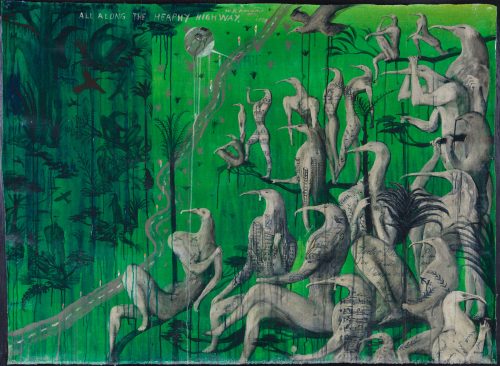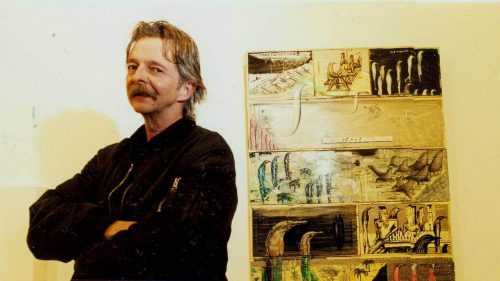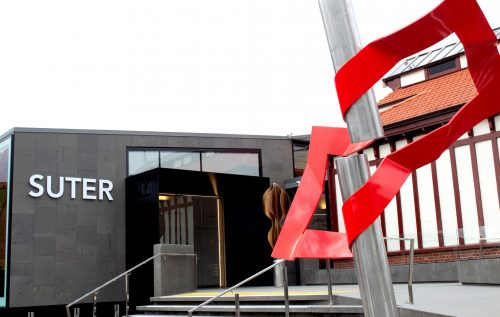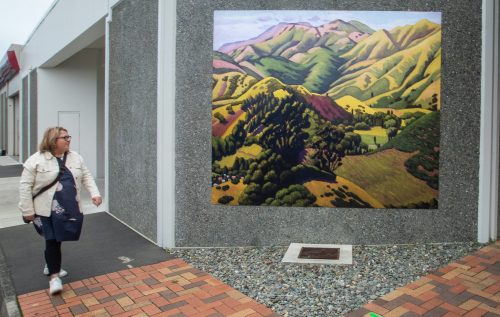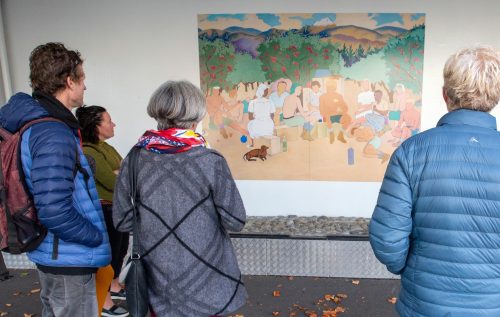Bill Hammond, 1994.
Significance of the work to the Suter Gallery
All Along the Heaphy Highway is an extremely significant painting in The Suter’s collection, as it would be regarded by any other NZ public gallery. It’s significant because it is a very good and characteristic example of his work, as well as featuring one of his most well-known motifs – the bird-headed people. In this region, the painting is relevant because of its story of the iconic Great Walk, the Heaphy Track, and the controversy that arose when it was proposed to put a road through from Golden Bay to the top of the West Coast. This area in the Kahurangi National Park is even more special now that the endangered flightless bird, the Takahē, have been released on the Gouland Downs, and might now be encountered by trampers.
The Suter’s Patron Sally Hunt helped buy the painting in 2010, at the time of approx. ¼ million dollars. The Gallery slowly and steadily fundraised from the community and applied for donation funds to repay Sally.
All Along the Heaphy Highway is popular with young and old alike – younger people are intrigued by the figures and characters in it, perhaps because they are like anime or cartoon, fantastical beings. For anyone who has walked the Heaphy, the contrast in the painting of light versus wet, gloomy and vividly green, sums up the transition from the Nelson side of beech forest, the Downs, the ‘enchanted forest’ (moss and limestone formations) to the wet and dense bush of the West Coast side…
Dr Esther McNaughton, The Suter’s Educator, uses the painting for her schools programmes, proving very popular with primary and intermediate students.
Heaphy Track
“Doing the Heaphy” is one of the must-dos for any New Zealand tramper. Located in the Kahurangi National Park, the track is 78.4kms, linking Kohaihai (north of Karamea on the northern West Coast) to the upper valley of the Aorere River, inland from Golden Bay. It is classified as one of New Zealand’s nine Great Walks by the Department of Conservation. It is usually walked in four or five days.
Māori are known to have settled along the lower course of the Heaphy River as early as the 16th century. There is evidence of exploration for pounamu (greenstone) in the Gouland Downs.
The first recorded visit to the area was in 1846, when Charles Heaphy, Thomas Brunner and their Māori guide Kehu explored the coastal sector of the track. The first recorded crossing of the whole range approximating today’s track was by a European gold miner, Aldrige, in 1859.
During and after the West Coast Gold Rush of the 1860s the area was extensively prospected for gold, with no return. Throughout the early 1900s, the track was all but forgotten until the creation of the North-west Nelson Forest Park in 1965, which became Kahurangi National Park in 1996, leading to re-development of the track.
The Heaphy Track is celebrated for its diversity – each walking day bringing different landscapes. Gerald Hindmarsh recently wrote a piece about the Enchanted Forest section.
Northern Link / Heaphy Highway
There have been intermittent calls for a road through Kuhurangi National Park, linking Karamea to Collingwood since the 1930s. It is an often-told story of developers versus environmentalists across various local and national governments, with continuously escalating costs ultimately outwaying the economic benefits (let alone the loss of a National Park).
There’s a well-written and colourful account of politicians vs trampers by Gerard Hindmarsh including the chaos of 1972/73 when thousands of trampers descended on the track, determined to cross it off their to-do list before the bulldozers came through.
Bill Hammond
Bill Hammond is one of New Zealand’s most influential contemporary artists. He was born in Christchurch in 1947 and attended the University of Canterbury School of Fine Arts. During the 1970s, he worked in a sign factory, made jewellery and designed and manufactured wooden toys before returning fulltime to painting in 1981. Birds first began to populate Hammond’s paintings after he visited the Auckland Islands in 1989, as part of the Art in the Subantarctic project. The three-week trip to the remote, windswept islands, where the severity of the climate has allowed little human impact on the natural environment was something of a revelation.
In an interview with Gregory O’Brien for Lands and Deeds (Godwit 1996), Hammond spoke of the islands as a kind of lost world, ruled over by beak and claw:
The Auckland Islands are like New Zealand before people got here. It’s bird land.
Hammond’s compositions encompass humour, beauty, and lyricism while reflecting a unique expression of New Zealand’s cultural landscape. His luscious palette of inky blues, his signature use of emerald green and gold and his endlessly inventive combination of anthropomorphic birds, horses and hybrid creatures were all distinctive to his work.
Hammond lived and worked in Lyttleton, passing away in January 2021. There is a fine obituary in The Press, and tributes on RNZ and by Lizzie Bisley, Curator of Modern Art at Te Papa.
Christchurch Art Gallery had a close relationship with Hammond, presenting a major retrospective in 2007, Bill Hammond: Jingle Jangle Morning. Have a look at their website for the full record of their collection, books, exhibitions, commentary and products related to Bill Hammond.
